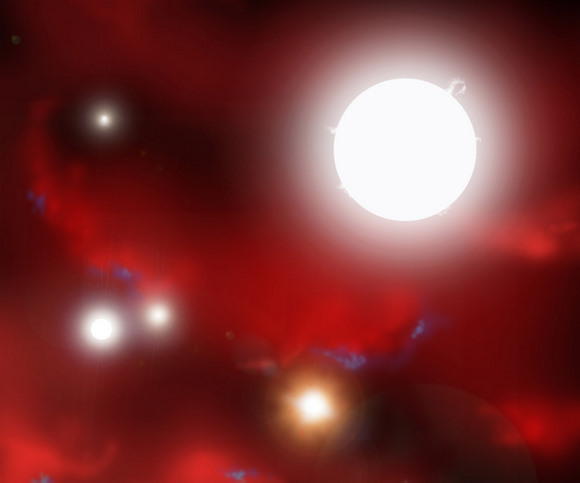[/caption]
What were the first stars like that formed shortly after the Big Bang? We don’t know much about the conditions of the early universe 13 billion years ago, but a new computer simulation provides the most detailed picture yet of the first stars and how they came into existence. The composition of the early universe was quite different from that of today, said Dr. Naoki Yoshida, Nagoya University in Nagoya, Japan and Dr. Lars Hernquist at the Harvard-Smithsonian Center for Astrophysics in Cambridge, MA. An article that will be published to the August 1 journal Science describes their findings from the computer model that simulates the early days of the universe, the “cosmic dark ages,” where the physics governing the universe were somewhat simpler. The astronomers believe small, simple protostars formed, which eventually became massive, but short-lived stars.
According to their simulations, gravity acted on minute density variations in matter, gases, and the mysterious “dark matter” of the universe after the Big Bang in order to form the early stages of a star called a protostar. With a mass of just one percent of our Sun, Dr. Yoshida’s simulation also shows that the protostar would likely evolve into a massive star capable of synthesizing heavy elements, not just in later generations of stars, but soon after the Big Bang. These stars would have been up to one hundred times as massive as our Sun and would have burned for no more than one million years. “This general picture of star formation, and the ability to compare how stellar objects form in different time periods and regions of the universe, will eventually allow investigation in the origins of life and planets,” said Hernquist.
“The abundance of elements in the Universe has increased as stars have accumulated,” he says, “and the formation and destruction of stars continues to spread these elements further across the Universe. So when you think about it, all of the elements in our bodies originally formed from nuclear reactions in the centers of stars, long ago.”
The goal of their research is to be able to figure out how the primordial stars formed, as well as predicting the mass and properties of the first stars of the universe. The researchers hope to eventually extend this simulation to the point of nuclear reaction initiation – when a stellar object becomes a true star. But that’s the point where the physics becomes much more complicated, and the researchers say they’ll need more computational resources to simulate that process.
Original news source: Harvard Smithsonian Center for Astrophysics


Finally some white stars. But, these should be blue! Dang!
Still it’s a great story. I’m made from some of these, but I don’t think it’s the yellow one. 🙂
Yes, the Population III stars are extremely interesting and have been popularly in the literature since the 1980s. Evidence in searching for these elusive objects have been mainly looking for white dwarf embers, whose unique spectra should be fairly pure in helium – best observed in the ultra-violet frequency of HeII at 164 nm (nanometers). The reasoning is that the first stars were “unpolluted” with ‘metals’ (Z parameter), being almost purely hydrogen and helium. (The article referenced below gives one thousandth to one ten thousandth these metals seen in today’s stars.)
An interesting very recent article on this at arvix
The search for Population III stars, by
Sperellodi Alighieri and colleagues. Who state these star theoretically could have been as massive as 500 solar masses, where as the biggest stars forming today is between 80 to 100 solar masses. (Although the large stars found in binary systems, where we have direct evidence, are around 30 solar masses.
The first real evidence of these Pop III stars was in 2003, with a strong HeII 164nm line was found in a dwarf lensed galaxy with at distance z=3.4. Another, which has strong possibilities of finding Pop II was found by Kurk et.al. in 2004 in the galaxy KCS 1166 with a z=6.518. Other possibilities are likely in the future.
It is interesting that direct observations continue to be difficult to prove because the time and fast evolution of these Population II stars in that they say;
“All these characteristics point strongly to the presence of Pop III stars, some of which might have already exploded to partially enrich.[these galaxies]… this [discovered] uncontaminated signature of Pop III stars might have a much shorter duration in the massive galaxies, which are the only observable galaxies at high redshift. This might be the reason why Pop III stars have not yet been detected at high redshift, where they have been searched so far,”
No doubt the future investigations into these predicted stars with find evidence to prove the theorists right.
It’ll be interesting to see what happens if they get the additional computing power.
Keep on working fellas
“…all of the elements in our bodies originally formed from nuclear reactions in the centers of stars, long ago.”
ALL? We are not just made up of heavy elements which require stellar nucleosynthesis. A goodly portion of us is hydrogen. How do they know that some of that hydrogen isn’t original material from the creation of the universe?
I like what they’re doing, but it’s pointless. Their results are only as good as the data and program they used. We do not know, nor will we ever know what the conditions were at the moment of creation or what happened shortly after the big bang. As far as a guess is concerned, it’s interesting, but a guess is all it is.
Hi Clint
Guess? The next space telescope will able to see them – so call the simulated stars “observational hypotheses” not guesses.